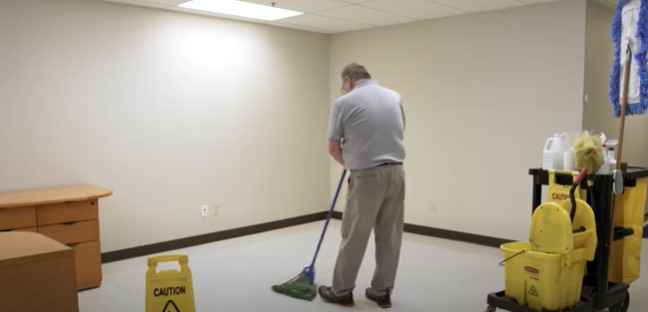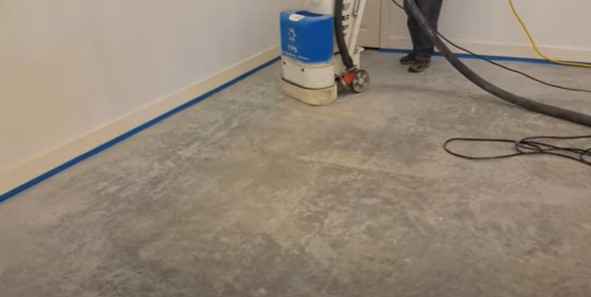To clean a floor in a wet room, first remove debris with a damp mop and then disinfect with a suitable cleaner. Ensure proper ventilation while cleaning to prevent moisture buildup.
Maintaining a clean and hygienic wet room is essential for both safety and longevity. Wet rooms are areas designed to handle water efficiently, often found in modern bathrooms, incorporating walk-in showers without traditional shower trays.
Cleaning them regularly prevents the accumulation of soap scum, mildew, and bacteria that thrive in moist environments. Let’s explain here about “How to Clean Floor in Wet Room?”
It’s essential to use cleaning products that are non-abrasive yet effective against grime and germs. Regular maintenance not only keeps the room safe and aesthetically pleasing but also extends the life of its fittings and surfaces.
Follow these straightforward steps to ensure your wet room remains spotless, hygienic, and welcoming.
Introduction To Wet Room Flooring

Wet room flooring plays a pivotal role in modern bathroom design. This seamless and contemporary solution not only provides aesthetic appeal but also functionality. The basics of wet room flooring sets the stage for proper maintenance and longevity.
Definition And Characteristics Of A Wet Room
A wet room is an entirely waterproofed or tanked bathroom with a shower area at the same level as the rest of the floor. Key characteristics include:
- Seamless surfaces for ease of cleaning and mobility,
- No barriers like shower trays or steps,
- Uniform flooring that leads to a drain,
- Waterproofing to prevent leaks and moisture damage.
Importance Of Maintaining A Clean Wet Room Floor
Cleanliness in a wet room is of utmost importance for several reasons:
- Mitigating slip hazards by removing water and soap residues,
- Preventing mold and mildew growth that can damage the structure and health,
- Keeping surfaces hygienic to eliminate germs and bacteria,
- Ensuring the longevity of the wet room materials and finishes.
Pre-cleaning Preparation
Before diving into the deep clean of your wet room floor, proper preparation is key. This ensures a swift and effective cleaning process. Here’s how to get started.
Gathering Necessary Cleaning Supplies
First things first, assembling the right tools does half the job. A well-prepared cleaning kit makes the task easier and faster. Here is what you will need:
- Non-abrasive floor cleaner – Gentle and suitable for wet rooms.
- Soft-bristle brush or mop – To scrub without scratching.
- Rubber gloves – To protect your hands from cleaners.
- Bucket – For mixing cleaning solutions.
- Squeegee – To help remove water and prevent water spots.
- Microfiber cloths – For drying and polishing surfaces.
Clearing The Wet Room Area For Unhindered Cleaning

Creating an uncluttered space allows you to clean without obstacles. Follow these steps:
- Remove all items from the floor, such as bathmats and containers.
- Relocate any movable furniture to another room.
- Keep the drainage area free of any blockages.
- Ensure good ventilation to speed up drying after cleaning.
A clear area guarantees you won’t miss any spots and the cleaning will be thorough.
Identifying Your Floor Type
Proper maintenance starts with knowing what you’re working with. Recognizing your wet room’s floor type is important. Doing so ensures longevity and sparkle. Below, we explore floor types and tailored cleaning techniques.
Different Materials Used In Wet Room Flooring

Wet room floors vary in materials. Some popular ones include:
- Ceramic tiles: Durable and water-resistant.
- Porcelain tiles: Dense and less porous than ceramic.
- Natural stone: Includes granite, marble, and slate.
- Vinyl: Slip-resistant and softer underfoot.
- Concrete: Modern look, seamless finish.
- Epoxy resin: Sleek and water-impermeable.
Custom Cleaning Approaches For Various Floor Types
Different floors need different cleaners. Learn the right approach for yours:
- Tiled Floors: Use pH-neutral cleaners. Avoid vinegar that damages grout.
- Natural Stone: Special stone cleaner is a must. Acidic products cause harm.
- Vinyl: Gentle cleaners; rinse with water. Abrasives are a no-go.
- Concrete: Mild, pH-neutral detergents work best. Rinse thoroughly.
- Epoxy Resin: Avoid harsh scrubbing. Mild soap and water are ideal.
The Cleaning Process
Cleaning the floor in a wet room keeps the area hygienic and looking sharp. Below are the best methods to tackle different surfaces within your wet room. Follow this process to ensure a sparkling finish with every clean.
Step-by-step Guide To Cleaning Tile Floors
- Gather Supplies: You’ll need a mop, bucket, pH-neutral floor cleaner, and soft-bristle brush.
- Sweep or Vacuum: Remove loose dirt to prevent scratches on your tiles.
- Mop with Warm Water: Start with just water to wash away easy-to-remove dirt.
- Apply Cleaner: Use the pH-neutral cleaner according to instructions for a deeper clean.
- Scrub Grout Lines: Clean grout with a soft brush to prevent discoloration.
- Rinse Floor: Rinse the floor with fresh water to remove any soap residue.
- Dry Floor: Avoid slips by drying the floor with a clean towel or mop.
Approach For Cleaning Non-tile Surfaces
- Identify Surface Material: Use appropriate cleaners for wood, vinyl, or concrete.
- Remove Debris: Clear away any particles using a soft broom or vacuum.
- Choose the Right Cleaner: Use a suitable cleaner for the specific surface type.
- Soft Cloth is Key: Wipe surfaces with a soft cloth to avoid scratches.
- Rinse Carefully: Ensure no cleaner residue is left by rinsing well.
- Dry Thoroughly.: Prevent water spots and slippage with a dry cloth or towel.
Effectively Cleaning And Sanitizing Drains
Keep drains in your wet room free from clogs and bacteria:
- Wear Gloves: Protect your hands before starting the cleaning task.
- Remove Debris: Take out any visible obstructions like hair and soap scum.
- Use Sanitizer: Pour a drain-safe sanitizer to kill germs and eliminate odors.
- Flush with Hot Water: Send down a flush of hot water to rinse away the residue.
- Regular Maintenance: Keep drains clear by repeating this process monthly.
Addressing Stubborn Stains And Buildup
Tackling stubborn stains and buildup in a wet room requires patience and the right approach. Over time, floors can accumulate grime that resists regular cleaning. Describe it how removing these tough stains will restore your floor’s shine and hygiene.
Techniques For Removing Tough Stains
Sometimes, spots on the floor won’t budge with normal mopping. Here are effective ways to tackle them:
- Vinegar Solution: Mix equal parts of water and vinegar. Apply the solution to the stains and let it sit before scrubbing.
- Baking Soda Paste: Create a paste with baking soda and water. Spread over stains, leave for a few minutes, and scrub.
- Specialized Cleaners: Some stains may require chemical cleaners designed for bathroom floors. Use as directed.
For substances like hard water deposits, a pumice stone can gently break down the buildup without scratching the floor.
Preventing And Removing Mold And Mildew
Mold and mildew thrive in wet environments and can be health risks. Keep these at bay with these tips:
| Prevention | Removal |
|---|---|
| Ensure proper ventilation to reduce moisture. | Use a hydrogen peroxide solution to kill mold. |
| Wipe down wet surfaces after use. | Apply a mixture of bleach and water to the affected areas. |
| Regularly clean with anti-fungal solutions. | Consider a mold removal product for persistent growth. |
Mold should be removed promptly to prevent health issues and further spread. Always wear protective gear like gloves and masks when handling mold and mildew.
Post-cleaning Care
Cleaning a wet room floor doesn’t end with mopping and scrubbing. Proper post-cleaning care ensures the area remains safe and pristine. Follow these essential steps to maintain the spotless shine and prevent mishaps.
Drying The Floor Properly To Prevent Accidents

After a deep clean, immediate drying is vital. Wet floors can be slippery hazards. To avoid accidents, use the following method:
- Grab a clean, dry mop or absorbent towel.
- Gently glide it over the surface, soaking up excess water.
- Ensure no puddles or damp spots remain. Check corners and edges closely.
Consider using a dehumidifier or fan to speed up the drying process in no-ventilation spaces.
Regular Maintenance To Keep The Floor Clean
Maintaining a clean wet room floor is key. Adhere to a consistent cleaning schedule to prevent build-up. Here’s a simple guide:
- Daily wiping reduces water spots and mildew.
- Weekly mopping with a mild detergent keeps the floor hygienic.
- Monthly grout checks help catch early signs of wear.
| Frequency | Task | Benefit |
|---|---|---|
| Daily | Wipe Down | Prevents Water Spots |
| Weekly | Mop | Removes Dirt and Bacteria |
| Monthly | Grout Check | Extends Floor Life |
To help protect the floor, use doormats to catch debris and wipe up spills promptly. For an extra layer of protection, consider a sealant recommended for wet room materials.
Tips And Tricks For A Spotless Wet Room
Keeping a wet room spotless is a task that demands the right approach. With high moisture levels, these areas are prone to dirt build-up and the spread of bacteria.
Regular maintenance and an efficient cleaning routine are keys to a clean and fresh wet room.
Natural Cleaning Solutions For Eco-friendly Cleaning
Harness the power of nature to keep your wet room sparkling. Here are some natural cleaning solutions:
- Vinegar and Water: A mix of equal parts can tackle grime.
- Baking Soda: Great for scrubbing without scratching surfaces.
- Lemon Juice: Natural bleach that leaves a fresh scent.
Mix these ingredients to create a powerful, non-toxic cleaner for daily use.
Expert Advice To Prevent Future Dirt Accumulation
Prevention is better than a cure. Use these expert tips to reduce dirt build-up:
- Squeegee After Use: Quick wipe down to prevent water spots.
- Dry Towels: Hang them outside the room to minimize dampness.
- Sealant Checks: Regularly inspect and touch up to prevent mold.
Establish a cleaning schedule to tackle dirt before it becomes a problem.
Frequently Asked Questions For How To Clean Floor In Wet Room
What Is The Best Way To Clean A Wet Room Floor?
Begin by sweeping or vacuuming to remove loose debris. Use a mild detergent and warm water to mop the floor, then rinse with clean water. Dry with a squeegee to prevent water spots and mildew growth.
What Do You Put On The Floor Of A Wet Room?
For a wet room floor, use non-slip tiles, vinyl flooring, or specifically designed wet room floor formers that ensure water drainage and safety.
How Often Should A Wet Room Floor Be Changed?
A wet room floor typically needs changing every 5 to 15 years, depending on material quality and usage. Regular maintenance can extend its lifespan.
How Do I Keep My Floor From Getting Wet In A Wet Room?
To protect your wet room floor from water damage, ensure proper sealing and waterproofing. Install a suitable drainage system. Use water-resistant materials for flooring. Regularly maintain seals and grout, and consider using water-absorbing mats near showers or baths.
Conclusion
Maintaining a clean wet room floor is vital for hygiene and safety. Regular cleaning with the right tools and solutions keeps mold and mildew at bay. Maintain these simple yet effective techniques for a sparkling floor. Your wet room will not only look inviting but also stand the test of time.
Happy cleaning!

